[Part 1 of this post appears here.]
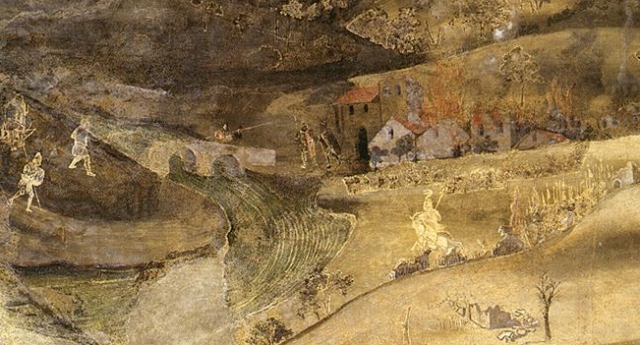
A desolate, uncultivated countryside; a burning village; ruined houses; marauding soldiers—these are the first things visitors to the council chambers in 14th century Siena would have seen of Ambrogio Lorenzetti’s magnificent fresco series known as the “Allegory of Good and Bad Government.” The original entrance (now displaced several yards to the right) opened onto a stark depiction of how a society could fail utterly in the fundamental task of providing for itself—how it could destroy rather than construct its niche.
The grim scene was meant to serve as a stern lesson to “the Nine”—the magistrates who served as Siena’s governing body, and who commissioned the work. It would appear to their left—the sinister side—as they conducted their business, the pictorial conclusion to an allegorical narrative showing how injustice corrodes society. The narrative’s implied injunction against unjust rule works in conjunction with the pictorial narrative on the opposite wall, to the magistrates’ right: the image of the thriving countryside I discussed in my previous post.
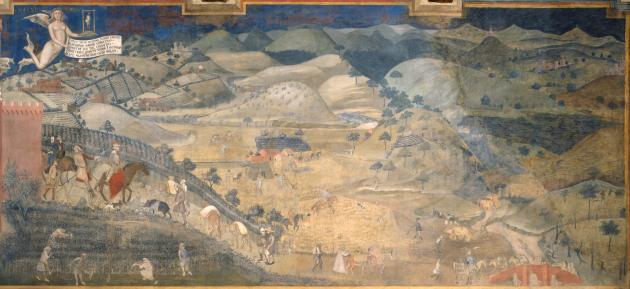 Right hand wall (right half): The thriving countryside
Right hand wall (right half): The thriving countrysideThere I interpreted the scenes of agricultural productivity—coupled with scenes of the vibrant economic and cultural life of the associated city (seen below)—as Lorenzetti’s depiction of the fruit of a just civic republican political order. Lorenzetti paints the city and country-side as an integrated system; the country-side is not a niche in which the city is placed, but rather the city and country-side constitute a niche jointly. Though the agrarian practices Lorenzetti represents are manifestly niche construction activities, he grasps that human beings must do more than sow and harvest to survive. Specifically, they must construct the social conditions in virtue of which those activities can take place. Both pictorially and by incorporated text Lorenzetti indicates that the precondition for niche construction is security, which he includes in a network of conceptual associations with peace, and justice. Peace and security are products of the political effort to ensure justice within the complex social relationships among citizens that constitute their niche—the system by which they sustain their survival as individuals, and the survival of their city.
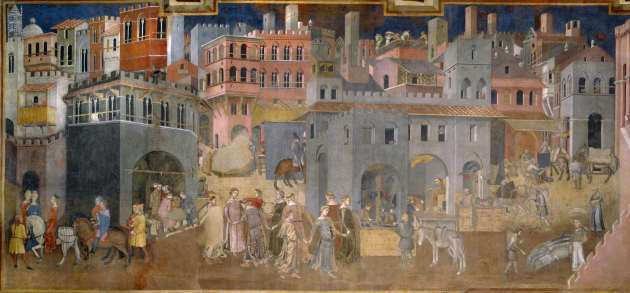 Right hand wall (left half): The thriving city
Right hand wall (left half): The thriving cityThe elaborate panorama of a flourishing social system, underpinned by justice, was no doubt an idealization—but it invites viewers to envision what Siena could be. In particular it kept before the rulers an attractive goal for their rule, and reminders of the moral attitudes they should adopt to achieve it.
But a quick turn of the head makes it perfectly clear that Lorenzetti knew—and wanted his viewers to recognize—what could possibly go wrong with this picture. On the hope that the political ideas Lorenzetti expresses are still meaningful I will review his account of what can go wrong. First, though, I want to acknowledge some other ways we today might think things can go wrong, but which we bring to rather than take from the fresco.
The picture celebrates the activity of niche construction, including the transformation of the landscape it involves, and it accepts as given and rightful the stratification within the social system that constitutes the human niche it displays. I will leave aside the latter topic to present a more environmental concern: Lorenzetti’s uncritical acceptance of human niche construction itself. For it might be argued that the environmental crises identified with the Anthropocene can be seen as “Nature’s revenge” against humanity’s overweening efforts to dominate it. At one level, the celebration of niche construction thus seems premature, since our exploitation of natural systems can have unintended consequences that make the niche we have constructed less habitable. At a deeper level, therefore, the celebration of niche construction can seem misconceived; maybe what’s wrong with the picture Lorenzetti paints is that it represents an instrumentalist attitude toward Nature that we should actually reject.
But these do not seem to be Lorenzetti’s own concerns; for him the real challenge to human niche construction comes not from anything in Nature, but from human beings themselves. What can go wrong with the picture on the right hand wall is not Nature’s revenge, but human injustice.
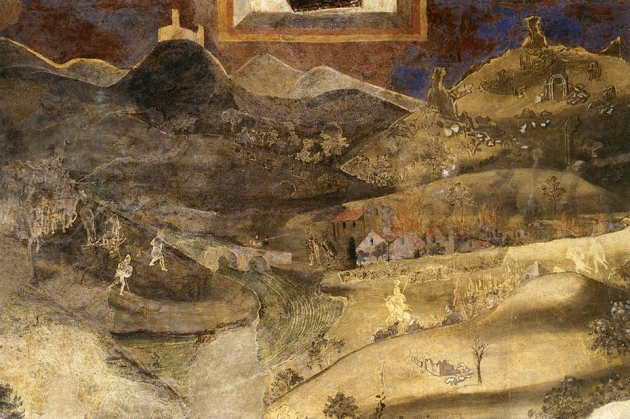 Left hand wall (left half): The effects of injustice on the countryside
Left hand wall (left half): The effects of injustice on the countrysideThe blasted landscape on the left hand wall has had its productivity destroyed: it cannot support the lives of the people in the associated city; unlike on the right hand wall, there is no one bringing goods from farms to the urban market. The agricultural failure is anthropogenic, but not mediated through a chain of environmental causes and effects—as when, in a case of niche construction backfiring, bad farming practices lead to soil depletion. Rather the damage is anthropogenic in a direct sense, resulting from the violence inflicted by the armed men roaming the landscape, wrecking the agricultural infrastructure—an example of literal niche destruction.
 Left hand wall (right half): The effects of injustice on the city
Left hand wall (right half): The effects of injustice on the cityThe left hand wall as a narrative unit makes clear that the source of the destruction is the city associated with the landscape, due to the perverse political values by which it is governed. In contrast to the right hand wall, which shows noblemen passing from city to countryside for leisure, the left hand wall shows a trio of armed figures leaving the city (through the gate at the left side), presumably to pillage the countryside.
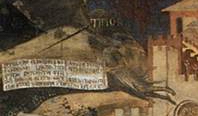
Detail: Fear (Timor). The banner reads: Because each seeks only his own good, in this land Justice is subjected to Tyranny: wherefore, along this road nobody passes without fearing for his life, since there are robberies outside and inside the city gates.
This contrast is heightened, and explained, by the allegorical figures that appear in corresponding positions on the two walls, both at the interface of city and countryside, moving from the former to the latter. As I discussed in my previous post, the right hand wall features the figure of Security—the political accomplishment of the good city that is the condition for both productive activity and trade that benefits city and countryside alike. The left hand wall, as Diana Norman puts it, features “the grim allegorical figure of Fear, represented as a haggard woman in ragged clothes and armed with a menacing black sword. Her position—in flight over the city walls, in the general direction of the countryside—suggests that she is a malign influence emanating from the city itself” (1997, p. 314).
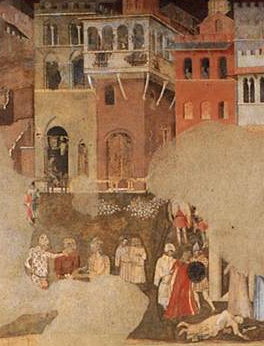
The road between city and countryside, that is, represents the systemic character of the human niche: the interactions between city and countryside are what underpin human life. On the right hand wall the political accomplishment of security allows for those interactions; the system is fully functional, and there is abundance in both zones. On the left hand wall the system has broken down. Not only is the countryside blasted and the road empty, the bad city is devoid of economic activity (except for a blacksmith making weapons, in doorway on left), and is instead a scene of violent assaults (lower right). Lorenzetti even depicts—in contrast to the construction work on the right wall—a building being demolished (upper middle): another vivid emblem for the idea of niche destruction.
The failure of the society presented on the left hand wall to maintain its niche, indeed, the fact that it has destroyed it, is explained by way of a contrast with the explanation Lorenzetti presents for the success of niche construction on the right hand wall. The explanation is summarized on the banner carried by the figure of Fear. Of course this inverts the moral associated with the figure of Security, which refers to the absence of fear. The moral associated with Fear attributes the absence of security to the overthrow of Justice by Tyranny.
 Lorenzetti depicts precisely this at the right end of the left hand wall—the starting point for the allegorical narrative that flows right to left. Tyranny is shown as a demonic figure, surrounded by personifications of vices, with Justice defeated and bound at her feet (Lorenzetti’s text refers to Tyranny as female). As a text panel beneath the figure makes clear, Tyranny is responsible for the desolation depicted throughout the rest of the left hand wall: “She always protects the assailant, the robber, and those who hate peace, so that her every land lies waste” (emph. added). Niche destruction, Lorenzetti suggests, is a political consequence.
Lorenzetti depicts precisely this at the right end of the left hand wall—the starting point for the allegorical narrative that flows right to left. Tyranny is shown as a demonic figure, surrounded by personifications of vices, with Justice defeated and bound at her feet (Lorenzetti’s text refers to Tyranny as female). As a text panel beneath the figure makes clear, Tyranny is responsible for the desolation depicted throughout the rest of the left hand wall: “She always protects the assailant, the robber, and those who hate peace, so that her every land lies waste” (emph. added). Niche destruction, Lorenzetti suggests, is a political consequence.

Figure of the Common Good in the Allegory of Good Government
I will close by elaborating the civic republican quality of Lorenzetti’s view. Niche destruction, he shows, is the consequence of unjust attitudes among the citizens. Tyranny triumphs over Justice, Fear’s banner declares, “because each seeks only his own good.” In line with traditional civic republican theory, Lorenzetti frames this idea in terms of dedication to the Common Good. Where Justice rules, according to text on the center wall (showing the Allegory of Good Government), the citizens “make the Common Good their Lord”—but “where Justice is bound, no one is ever in accord for the Common Good.”
The relations between self-seeking, injustice, and the common good are too complex to unpack here. At bottom Lorenzetti seems to uphold an ideal of fair reciprocity in people’s dealings with each other; this is the norm “the assailant, the robber, and those who hate peace” violate, undercutting the ability of people to interact cooperatively to provide for flourishing lives.
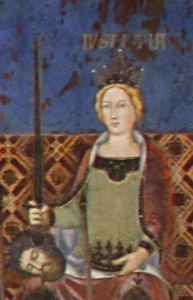
Figure of Justice in the Allegory of Good Government
The image of the Tyrant thus seems to figure not just a form of government, but a moral climate; tyranny allows (perhaps encourages) people to act on selfish impulses that are restrained by a regime dedicated to justice. In the same way that, in the civic republican tradition, peace is not simply an absence of discord but a victory over it, justice within a society is that society’s victory, achieved by its political system, over tendencies that lead people to act unjustly—hence the fresco’s many images of punishment. Maintaining the proper moral climate, from the civic republican perspective, is at the core of the social project of niche construction. If that climate is not sustained, the niche will be destroyed.
Zev Trachtenberg (ORCID: https://orcid.org/0000-0002-2084-9103) is a Professor of Philosophy at the University of Oklahoma.

A couple of initial thoughts about a very stimulating post on a painting that I truly love:
An empirical question about security: What about the plague of 1348 that actually destroys the niche right after Lorenzetti completes the painting and that more or less forever dooms Sienese republicanism? It’s not so much Nature’s revenge (a la the Anthropocene) as a reminder that the niche is a figure constructed out of a ground against which it is then set up, and that background is never entirely passive, knowable, controllable — never entirely transparent to itself. Securitas is never total — thankfully for those of us today living in “security states” of one sort or another. The niche is inevitably made up of unpredictable stuff, so it happens that sometimes this stuff behaves as expected, which is to say unpredictably. What is more, because we know that we cannot know when things like plagues will surprise us, the niche cannot be constructed in a way that prevents such things altogether. However, the niche can be constructed to mitigate the effects of such occurrences to the extent possible. Does Lorenzetti account for this, or is this the tragic flaw in his vision? Has he (and, by extension, Siena) built a house of cards blown over by the first whiff of plague?
A related thought on order and disorder, both artistically and socially: The composition of the work is tightly controlled, on the one hand, with an elaborate compositional scheme to organize a sophisticated conceptual framework asserting the virtues of civic republicanism. As you rightly point out, careful spatial decisions were made about how the Nine would encounter and relate to the painting. It’s planned down to the last brushstroke. That said, and perhaps as a result of this, it’s also a totally awkward and forced composition, forced to fit the walls of the room as they are, forced to find parallels where parallels need not obtain (oppositions are neither so neat nor so complete as this massive allegory asserts), forced to maintain a balance that is often at odds with the realities of the room or of the subject matter being treated, and so forth. Everything about the painting teeters, and its precariousness — not just the depicted precariousness of civic republicanism against the possibility of ruination but the precariousness of that very opposition itself — comes to the fore as the painting’s unconscious expression. There is a lot to admire about the Sienese political experiment, but I wonder if the “left vs. right” opposition (in contemporary parlance) between the “good” republic and the “bad” tyranny is not so much an idealization as an oversimplification on Lorenzetti’s part — the illusion of a duality where there isn’t one and the corresponding failure to assert a duality where there might be one. For instance, there is no room here for dissent as a healthy part of the social order because why would you need a whistleblower when security reigns? Indeed, the demands that the painting places on virtuousness are themselves tyrannical! Representation — political or pictorial — is wobblier than this, more errant, more corrupt, and Lorenzetti (or, perhaps, his patrons) want to push this out of the picture, so to speak. Well, if it’s not in the picture, then it’s still in the room and the world beyond.
Robert–thanks so much for this comment, and for the wonderful discussion we just emerged from. Very quickly, and I think this responds to both of your points–my reading of the picture is very much about what is inside its borders, and indeed I think the picture itself is very much about what is inside its borders. So it does not seem to foresee danger coming from outside the space it depicts (e.g. rats from Central Asia), nor from moral sources outside its own conceptual scheme (e.g. tensions arising from even a “legitimate” political hierarchy. Thus, as you observed in our discussion, Lorenzetti does not show the sources of the rivers that flow through the landscape–he just takes those environmental inputs (Natural capital?) as given, an unexamined assumption that there is a stable physical basis for niche construction to operate on.
(Though, as I mentioned, it is interesting that Lorenzetti depicts grape vines as planted perpendicular to the slopes of hills–an agricultural technique designed to work against the erosion caused by what was apparently the common practice of planting them parallel to the slope (according to Meoni, cited in the first post). Thus, while not alluding to “exogenous” threats to niche construction–i.e. from outside the socionatural system he depicts–he seems to recognize the need to do niche construction intelligently–as we might say sustainably.)
As to the precariousness of the republic–as I understand that is a constant theme in the civic republican tradition. So the visual instability you note might be an acknowledgement of the constant vigilance needed to maintain the republic against the ravages of time (or, to maintain the niche, and the life within it, against the forces of entropy).
I’ve been meaning to comment on this post for some time now – finally getting around to it. The thought I had in our in-person meeting on December 20 was that this mural can be interpreted as a work of speculative fiction. In view of recent scholarly work in literary and cultural studies on “Cli-Fi” or climate fiction, and the urgent need to imagine what a warmer future will look and feel like, I find this mural to be an interesting historical precedent. One question comes to mind: speculative fictions often play with temporality, set in futures or in the past, or dealing with time-travel or what critics call “slipstream” narrative. Is Lorenzetti’s mural, then, a history, a prediction, a warning? What kinds of temporality are at play in this speculative fiction?
What a totally cool idea, Pete! Two quick thoughts. First, I think the two visions of the city and countryside (on the left and right walls) are not offered as visions of the future, but rather as “counterfactual presents” the way things could be now, if the rulers uphold or violate the political ideals depicted in the central allegory. I’m more convinced of this regarding the scenes of ruin on the left wall–because, according to Norman (1997) just those kinds of scenes were in recent memory, of a conflict with Pisa–and so are held up as an ongoing possibility. Regarding the right wall: the vision is clearly highly idealized–I doubt anyone would have seen it for Sienna as it actually was, but rather as as for the rulers’ aspirational self-image. In some sense both of these scenes can be construed as of a possible future, but I’d say of a near-term future, which is not a rupture from the present but an extension of it, best thought of as the realization of seeds present in the present (so to speak).
But as to rooms like this representing more distant pasts and futures . . . here we need an art historian (come in, Robert!), but something like the Arena Chapel in Padua comes to mind, with its depiction of the Biblical past, and eschatological future. The Lorenzetti frescos are apparently unusual in being so secular–there must be many, many fully illustrated chambers with religious imagery that makes use of temporality in ways closer to what I think you mean.